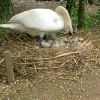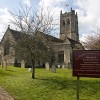One day in the 1980’s an ignominious lump of nondescript bone was brought into the Dorset County Museum in Dorchester by a Mr E Taylor. It soon became apparent however that it was a portion of the skull of an animal, for it bore sockets for the creature’s teeth and in its dimensions varied from 46 to 67 millimetres in size.
The skull fragment had apparently been caught up in a fishing net during a trawl for scallops off West Bay, west of Portland. As a remnant of an ancient vertebrate this find in itself was not that unusual, for the seabed in the area in question forms part of the world-renown (and richly fossiliferous) Jurassic Coast Heritage site, and consists of a stage of the Jurassic strata known as the Lower Kimmeridgian, after the village of that name near Kimmeridge Bay. Long before the discovery of the skull, numerous vertebrae of marine reptiles and possibly even of dinosaurs had regularly been obtained from the same area as tidal action wore away the enclosing rock. While some of these show wear and colonisation by bryozoans and worms, others are fresh-looking suggesting that the bones are still being eroded from the entombing clay.
But the West Bay skull-bone shows both fresh and eroded areas. From examination, it was clearly part of the skull of a large theropod dinosaur, and isolated and fragmentary bones of this kind are generally classified as Megalosaurus (or “large lizard”). This is a genus of dinosaur originally identified from Jurassic strata at Stonesfield in Oxfordshire. The type specimen exists as a group of bones first described by William Buckland in 1824. Although the specimen skull fragment from West bay is similar in general appearance, it evidently belonged to an individual much larger than the reptile(s) who’s remains were excavated from Stonesfield. Thus the latter’s subnarial height exceeds 164 millimetres, as compared with 110 mm for the Stonesfield specimens. The teeth are also relatively closer together in the Dorset example; the inter-dental plates relatively lower in height.



